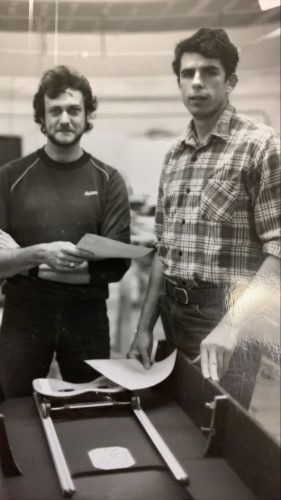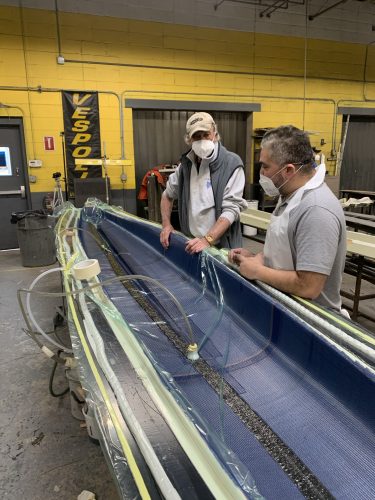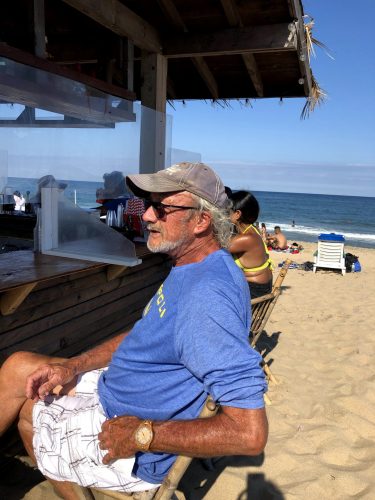
Pete Smith, Old School Master of New Technology
By Oli Rosenbladt
If you row a Vespoli, then Pete Smith knows your boat–very well, in fact. As Vespoli’s Senior Manufacturing Engineer, and Vespoli’s longest serving employee (39+ years with the company), Smith inspects every boat that leaves the factory–twice.
A native of Britain, Smith’s path to New Haven and Vespoli began when he was hired by the british rowing shell manufacturer Carbocraft in 1976. “We were the first boatbuilder in the world to use carbon fiber and honeycomb,” says Smith of his time at Carbocraft. “We got a lot of leftover materials from British Aerospace and used them to build rowing shells.”
The new approach to building boats paid off almost immediately, as the second eight that Smith and Carbocraft produced was used successfully by Oxford University to win the Oxford-Cambridge Boat Race for the first time in eight years.
Surprisingly, Smith wasn’t a “proper” rower before he began building racing shells. “I’d always been a boater,” Smith says of his early days in England. “I’d go fishing a lot on the Thames, and because I couldn’t afford a motor, I’d row a lot.” What Smith did have in those early days, when he answered an ad posted by Carbocraft, was experience building boats and working with carbon fiber and epoxy resin, a relative rarity in those days.
“We were using materials that no one else had used before,” remembers Smith. “Using carbon fiber made it possible to make boats stronger, stiffer and lighter.”
Vespoli USA founder Mike Vespoli originally produced Carbocraft boats under license in the United States, then brought Smith aboard when he struck out on his own under the Vespoli name in 1981. “Originally, I was going to come to the US for two years,” says Smith, looking back. “But two years turned into 39.”
On coming to New Haven, Vespoli was a small company with just a handful of employees. But within two years, as the operation picked up steam, the staff grew to over 40, with Smith at the helm of the manufacturing process.
“Pete Smith is old school,” adds Dave Trond, Vespoli CEO. “He’s a hard-working, lead by example, get the job done, type of guy. He’s passionate about his work and takes every aspect of it very seriously.”
At Vespoli, Smith is responsible for everything above the waterline in the Vespoli fleet. While the hulls are designed by naval architects, everything the rowers see, such as the cockpit, fittings, and riggers come from Smith’s mind.
“If we ever needed a new part for a boat, I would make it myself,” explains Smith. “Usually I start out by doodling from a block of foam, carving out the piece, and then we manufacture it in-house.” A case in point is the carbon riggers that Vespoli introduced in the fall of 2019–these started out as a pair of foam prototypes hand-carved by Smith before going into production.
“I suppose I have a little bit of a flair for the artistic,” says Smith of his creative work. “I used to do painting and drawing when I was younger.” Smith says that he’s very proud to see his handiwork turned into production work.
“The designs of boats and their construction has changed,” says Smith, reflecting on nearly four decades of building boats. “There’s been a lot of innovation.”
He’s being modest, according to Trond. “The world of composites is still relatively new and Pete has been building his expertise through hands-on experience since the 70’s. His composites knowledge outweighs many of the so-called experts and many of our vendors come to him for advice. If it’s made from carbon, Pete knows how to make it and make it better.”
Beyond the design and manufacturing of boats however, Smith’s contributions at Vespoli run far deeper, and this is acknowledged by his colleagues. “At the end of a long week, there is nothing better than sharing a pint or two with Pete and listening to his stories of the early years.”
And so, in an industry that seems to innovate and change by the year, Pete Smith’s old school approach with new materials is still paying dividends, and still putting rowers and scullers into fast boats.


